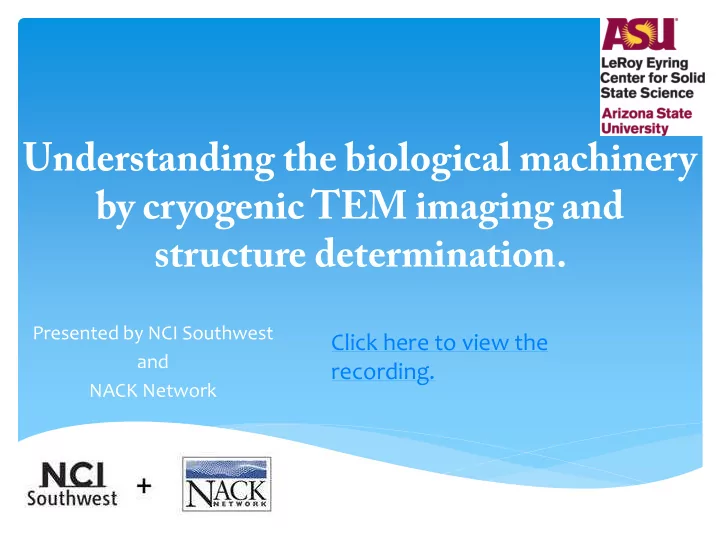

Understanding the biological machinery by cryogenic TEM imaging and structure determination. Presented by NCI Southwest Click here to view the and recording. NACK Network
This Webinar Is Hosted By ATE Central acts as an information Hub for the National Science Foundation ATE Grantee Community atecentral.net/webinars
Today’s Moderator and Host Trevor Thornton Michael Lesiecki NNCI Director: Professor of Electrical Co-Principal investigator Engineering NACK Support Center Arizona State University
Today’s Presenters Katia March Dewight Williams Associate Research Scientist Associate Research Scientist John M. Cowley Center for High Resolution John M. Cowley Center for High Resolution Electron Microscopy Electron Microscopy
2017 Nobel Prize in Chemistry Jacques Dubochet Richard Henderson Joachim Frank
Biological molecules: Nucleic acid DNA Chromatin
Biological molecules:
Biological molecules:
Biomolecular Fold Space: ∗ Traditionally protein structures were determined by ∗ X-ray crystallography: ∗ Captures only a single state because dependent on crystallization ∗ NMR spectroscopy: ∗ Captures dynamic states but limited size <60kDa ∗ A large number of private/public structure determination consortiums have solved ~150,000 protein structures add ~15,000 per year ∗ Soon all protein fold patterns will be determined. ∗ Structure determination will soon look toward higher order assembly, dynamic and or conformational variation, as well as in situ assembly states.
EM imaging can investigate this higher order assembly Organelles Orangisms Tissues Cells Podocytes Viruses Tricomes Proteins With image averaging methods, atomic resolution of complexes is possible
Why CryoEM? ∗ Biological chemistry occurs in water ∗ Biological molecules require water to properly organize ∗ Imaging in high vacuum is incompatible with hydration ∗ Best solution is freezing biology in vitreous (or water) ice. Jacques Dubochet
Cryogenic preservation ∗ As near native conditions as possible ∗ Water is frozen vitreously ∗ Plunge freezing in liquid nitrogen cooled ethane ∗ up to 5 micrometer ∗ High pressure freezer ∗ up to 500 micrometers
Plunge Freezing in detail Glow discharge grids to make carbon hydrophilic Apply protein solution to holey carbon grid (5 µL of 20-100 nM) Blot away excess liquid Rapidly plunge into liquid nitrogen cooled cryogen (liquid ethane) Sample preserved in ultra thin vitreous ice Holey carbon film
Plunge Freezing in detail Glow discharge grids to make carbon hydrophilic Apply protein solution to holey carbon grid (5 µL of 20-100 nM) Blot away excess liquid Rapidly plunge into liquid nitrogen cooled cryogen (liquid ethane) Sample preserved in ultra thin vitreous ice
Plunge Freezing in detail Glow discharge grids to make carbon hydrophilic Apply protein solution to holey carbon grid (5 µL of 20-100 nM) Blot away excess liquid Rapidly plunge into liquid nitrogen cooled cryogen (liquid ethane) Sample preserved in ultra thin vitreous ice carbon carbon carbon
TEM images are projection images New Yorker Magazine comics
2D projections to 3D structures From Frank, 3D EM of macromolecular Assemblies
Single particle reconstruction 10-30 electrons per Angstrom 2 Orientations unknown so computationally intensive 2D-projection images
SPR: overview Translational and rotational Multivariate statistical analysis Particle stack Alignment of particles and classification Now with references Common lines reprojection Angular and translational Reconstruction of 3D volume assignment to each class sum image
Central Slice Theorem
Computing a 3D Reconstruction Low Dose cryoTEM images have weak phase information per particle image, so 100,000’s to millions of views are required
Reconstructions are computationally intensive Reconstructions use to require 100’s of CPUs only available on a high performance computing cluster Recent improvement in code and GPU utilization has allowed reconstructions on high end workstations cisTEM, Relion, cryoSparc
Ice behaves different than other materials in the electron beam
Imaging protein in Ice Direct electron detectors make possible Beam induced motion Uncorrected Motion corrected Brilot et al. J Struct Biol. 2012 March ; 177(3): 630–637.
Direct electron detectors: CMOS APS ∗ Improved DQE especially at low frequencies ∗ Direct electron counting modes improve low frequency contrast ∗ High speed read out as movies (50 frames a second) ∗ correction of beam induced motion ∗ Specific dose selection ∗ Spatial frequency filtering based on beam damage
Counting modes have high low frequency DQE Centroid localization Source Gatan
Movies: motion correction and dose weighting Movie Files Sum image Fourier transform Frames Dose Info uncorrected 8 e - 4 2 Å 15 e - 8 4 Å 35 e - 18 8 Å corrected 65 e - 32 10 Å 100 e - 50 20 Å
Motion Correction during reconstruction: Particle polishing
Solving protein assemblies is now routine. Nature 553 , 233–237 (11 January 2018) Nature Communications 9 , Article number: 89 (2018) TRPV6 ATP synthase Nature Structural & Molecular Biology (2018) Nature Structural & Molecular Biology 25 , 53–60 (2018) Yeast Exocyst Nature Structural & Molecular Biology (2018) TRPV5 Prion filament
Building up biological assembly Tatyana Svitkina Movie 3: Tilt series Movie 4: Tomogram
Unstained cryogenic material Play Movie Movie 5: Julia Mahamid Max Planc Martinreid from Science 351, 969-972, 2016
Segmentation and template matching in volumes. Wilhelm et al. 2014
Future: ∗ How do we preserve and image thick cellular or tissue volumes? ∗ 4D TEM and conformational dynamics? ∗ Can we discern molecules when connected or layered?
Join us for our upcoming webinars
Recommend
More recommend